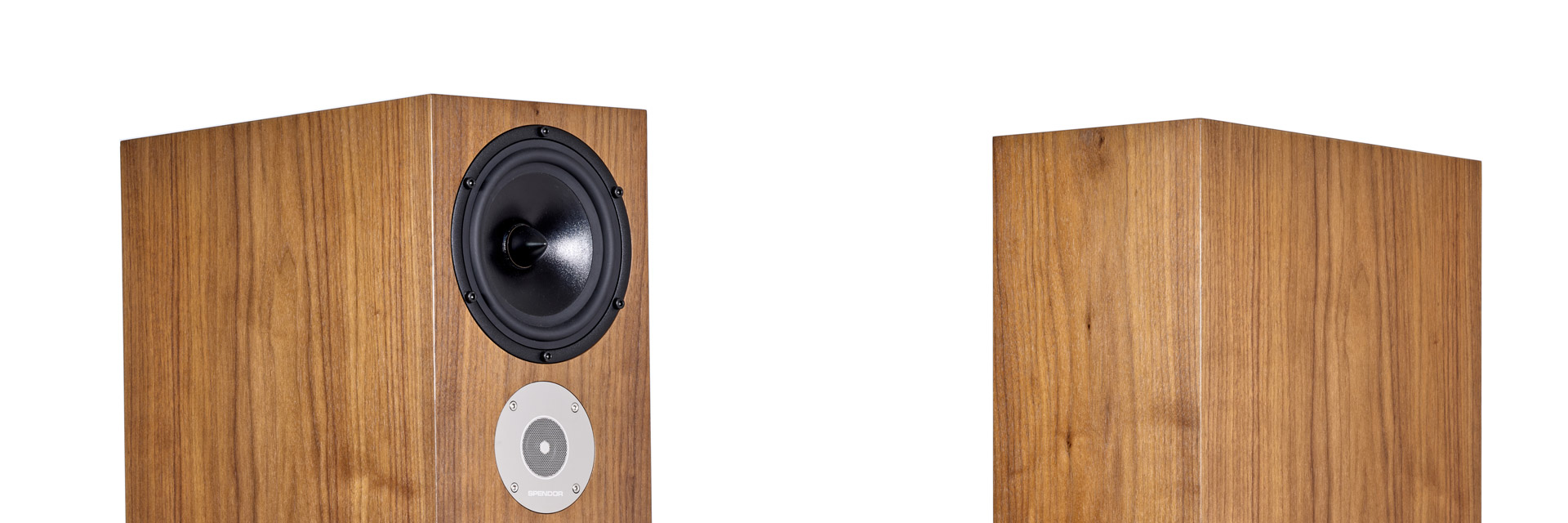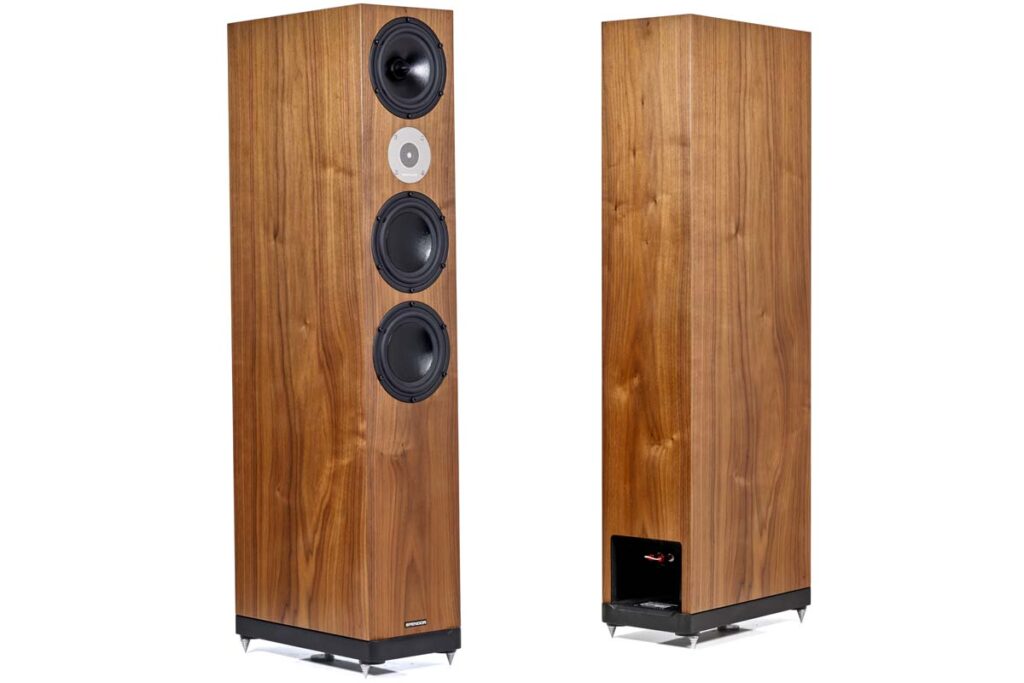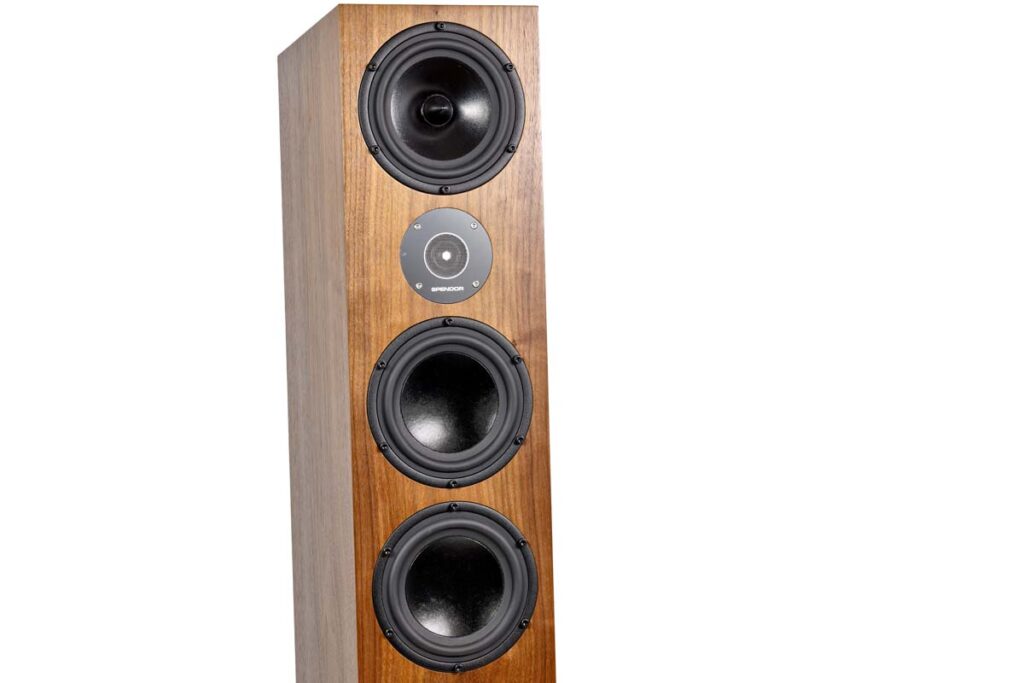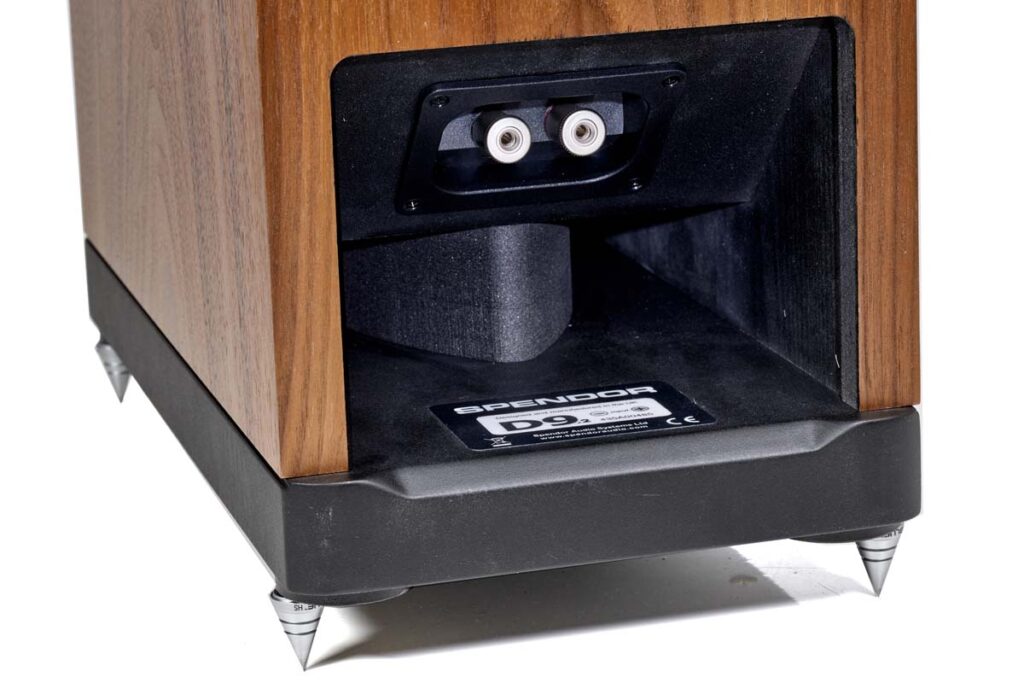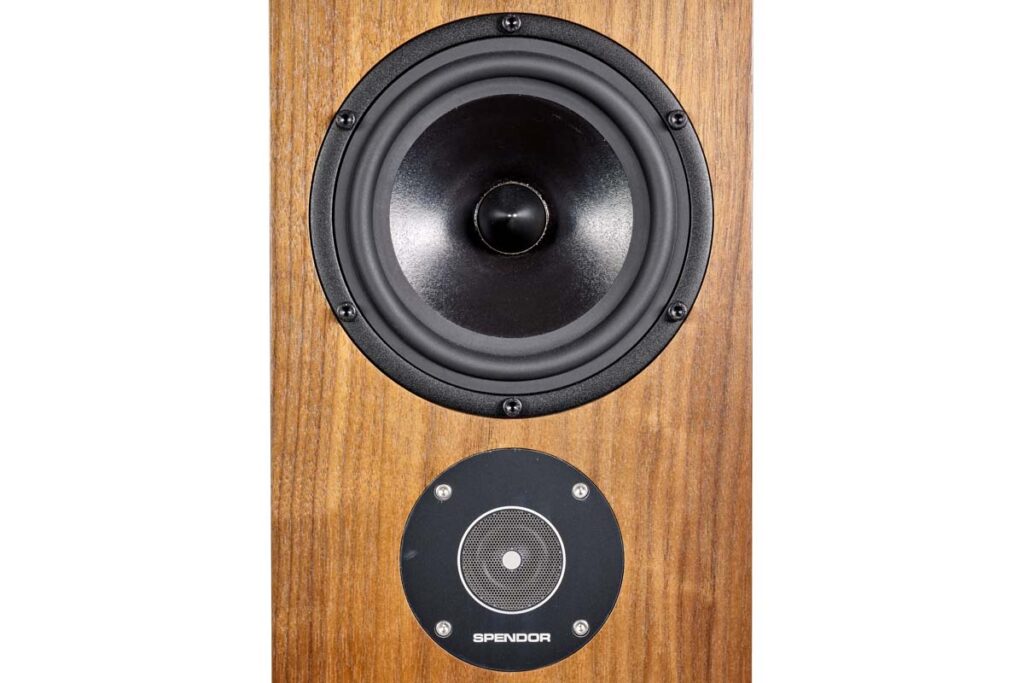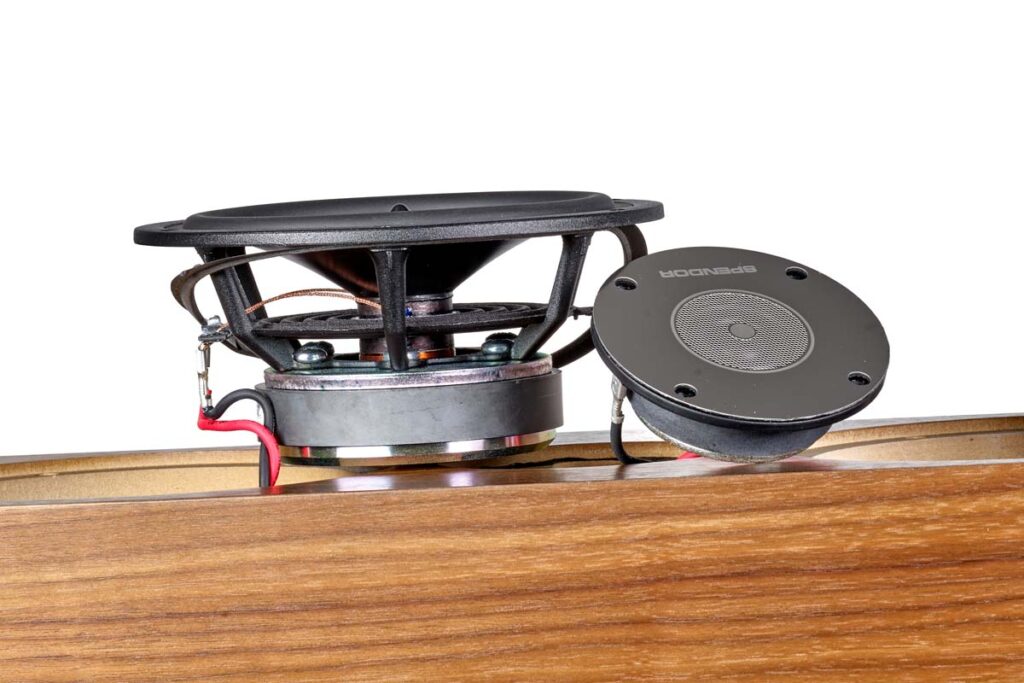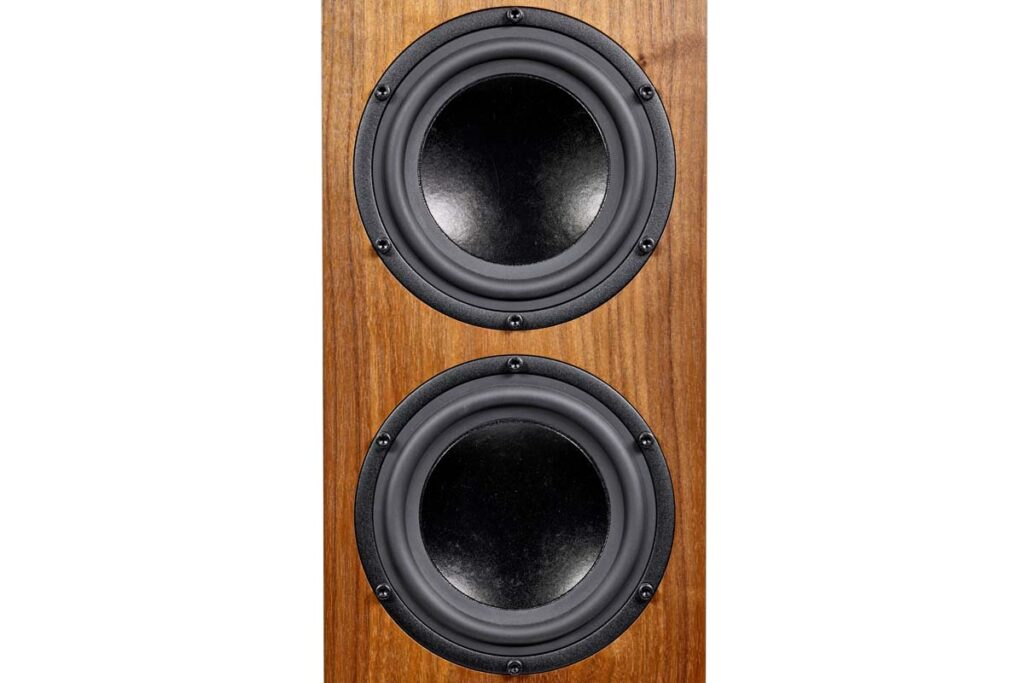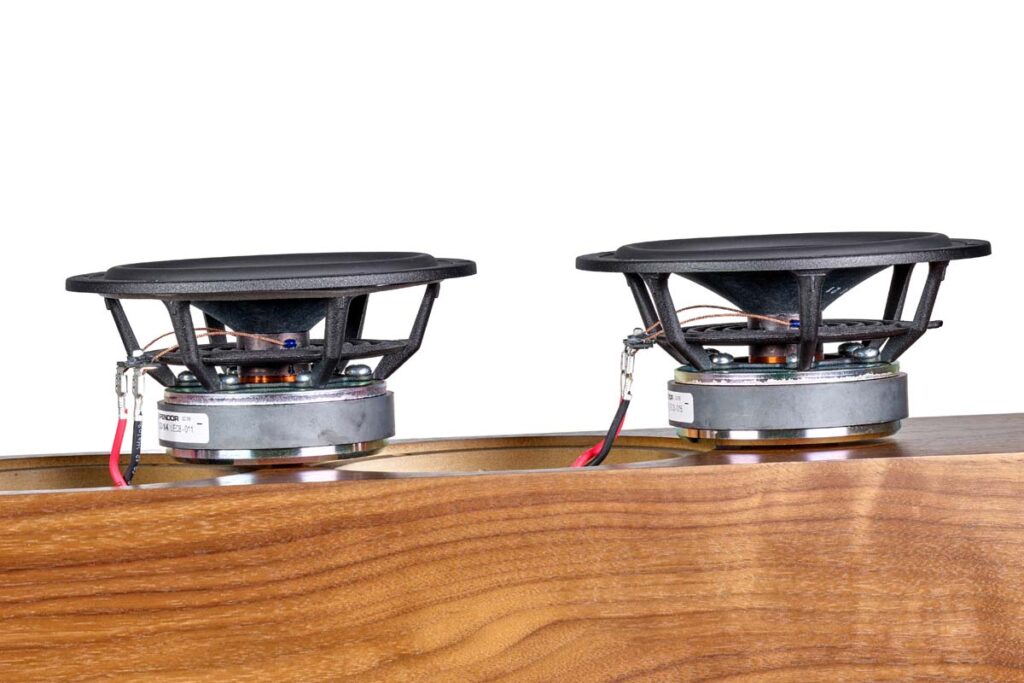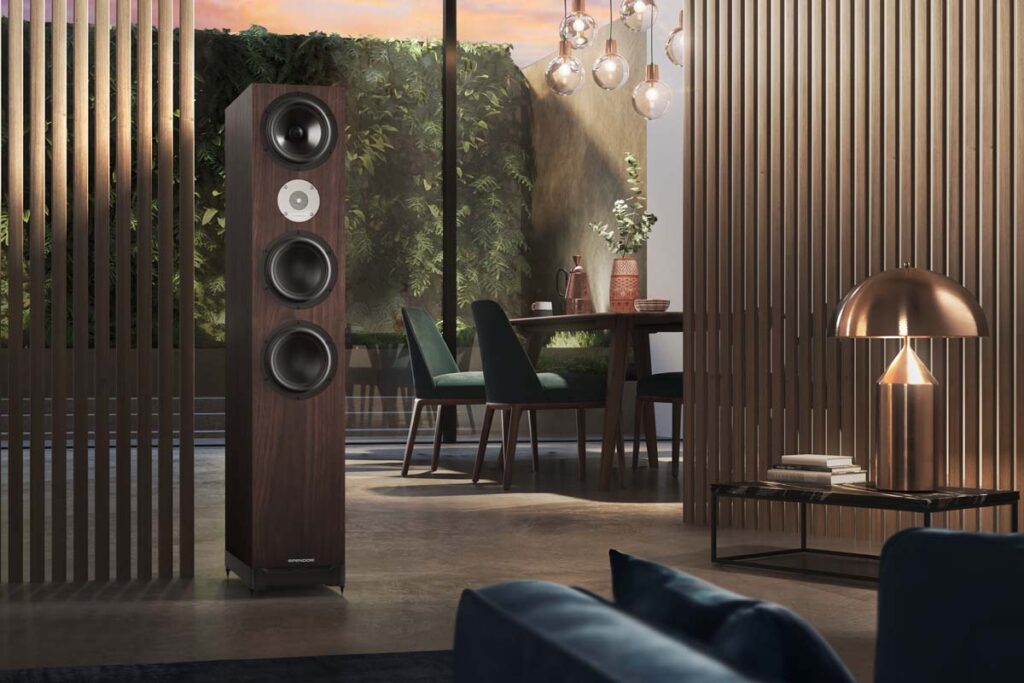“Spendor” equals “monitor”? That statement hasn’t been telling the whole story for a long time now. With the D series, the British company proves that they are just as adept at genuine high-end.
The speakers from Spendor’s D series don’t look like Spendor. They stand tall and narrow, so very different from the squat radio monitors on which the British manufacturer’s fame is based and which routinely give you headaches because of the special format of the required stand. “Is that manufacturer XYZ?” visitors ask me, pointing in the direction of the walnut-veneered columns, which from a distance show neither their origin nor their performance. Nobody guesses Spendor.
The D-Series is Spendor’s dedicated high-end line. It began in 2012 with the compact three-way floorstanding speaker D7, which picked things up where the S series had left ten years earlier. With the latter, Spendor had smoothed and streamlined the design while tuning it to favor the pursuit of bandwidth and neutrality over the hitherto subtly mid-centric voicing. The pair of Spendor S3/5s, which moved into the dorm of my then girlfriend and now wife at the beginning of the noughties, prove that this was a great success. We have lovingly cherished it ever since.
The Spendor D9.2 floorstanding speaker is a completely different animal compared to the small S3/5 loudspeaker. The larger of the two D models has set its sights on the dynamic high-end elite. It challenges the opposition in the disciplines of low bass, resolution, openness and liveliness. For the loudspeaker of the “conventional three-way port loaded” variety, the large Spendor surprises with a pleasingly tube-friendly sensitivity. After a close reading of the product history revealed that the 2019 update from the D9 to the D9.2 – in which, among other interventions, the “hot” treble was discreetly taken on a leash – had triggered a hailstorm of praise, my anticipation could hardly be greater.
The ingenuity of the developers is already evident in the spike mounts in the base plate. The slim D9.2s are on a rock-solid footing even without outriggers, as metal inserts allow the spikes to be mounted directly on the outer edge of the speakers. The connection terminal (single-wiring, thank you very much!) does not simply protrude from the rear panel, but has been integrated into the opening of the bass reflex system close to the floor. With its air flow guiding elements, port mouth looks way more elaborate than pretty much everything else on the market under the “bass reflex” label.
The finish of the cabinet leaves nothing to be desired. It is produced in-house. Spendor operates a cabinet joinery whose quality level is so high that numerous other well-known manufacturers also have their products made there. In a knock test, the MDF housing of the D9.2 shows a response that is well damped, but not acoustically dead. It stands to reason that the British company’s immense know-how is evident here, as many of the studio monitors of the 1970s and 80s, famous for their open and natural sound, are designed with cabinet walls that resonate in a controlled manner. Spendor uses the term “dynamic damping” for the D series and explains that this involves working with damping elements placed at specific points, instead of permeating the cabinet with a large number of struts and preventing any kind of natural resonance.
At first glance, the cone drivers look conventional, but they are developed and built in-house. Spendor manufactures the 180 millimeter diameter cone of the midrange driver from a polymer called “EP77” using a vacuum forming process. A composite material with a reinforcing Kevlar fiber component is used for the equally large woofers. The tweeter is a real eye-catcher. Its 22 millimeter diameter polyamide dome is covered up by a highly polished perforated metal plate. Spendor calls the whole thing “LPZ Tweeter”, the abbreviation stands for “Linear Pressure Zone”. The design aims to harmonize the pressure ratios on both sides of the cone.
My test pair reached me with the note “burned in”. And yet the sound changes drastically over the next 50 hours and continues to subtly but steadily increase in balance and refinement. Have you listened to a Spendor D9.2 and dismissed it as lacking in detail and bass? Then either the speakers have not been used for the recommended several hundred hours or they have been standing around silently for a long time. In optimum condition, the British columns play in an exemplary neutral and broadband manner. Anyone who experiences them differently should have a serious word with the sales person.
The Spendor speakers are a perfect fit for my room of just under 30 square meters. When experimenting with toe-in, it quickly becomes apparent that both the omnidirectional characteristic and the phase stability of the speakers are outstanding. The mid-range and tweeter fill the room with balanced sound over a wide arc while the actors on the virtual sound stage between the speakers are rock-solid in their positions, even if the listener moves half a meter to the right or left. Both of these factors indicate excellent development work in the construction of the crossover.
For 17 years, my reference in terms of loudspeakers have been the only slightly smaller two-and-a-half-way floorstanding Ayon Seagull/c speakers. They are real imaging wizards, dissolving completely with the first note and allowing the music to float in the room like a hologram. In this discipline, they also triumph over the Spendor speakers. In all other respects, the British speakers dominate the field. The extra cabinet volume and the presence of a midrange driver result in deeper bass and a seamlessly fast, open reproduction of voices and instruments that kept me glued to the system for hours on end during the first few days. The interaction between the drivers in the midrange and treble is phenomenal. Transients, such as the attack of percussion instruments or the snapping of strings, come in a flash and are so loose and free that in the best moments the illusion of real musicians in the room is created.
Coming from my midrange-less Ayon Seagull, with the Spendor D9.2 I immediately feel the sovereignty resulting from the additional diaphragm area. The midrange cone, which is active over more than three octaves, relieves the bass and treble drivers. This chassis is an absolute gem. It takes over the sensitive range of voices and acoustic instruments on its own and blows the finest veils of stress from familiar recordings, the presence of which I would never have suspected. To make absolutely sure that the so attractive impression of freshness and openness is not a trick from the magic hat of frequency response manipulation, I put on familiar sounds with violin (Gidon Kremer) and piano (Murray Perahia). The concert grand doesn’t come across as harder than usual, nor do steely undertones creep into Kremer’s violin playing. The Spendors retain a spotless record in tonal matters.
Classical music lovers will therefore love them for their subtlety and splendor of timbre. But how about a more visceral program? The moment of truth in terms of attack and power comes when the LP Transformation by the Bruce Katz Band lands on the platter of the dps drive – an audiophile gem from the AudioQuest Music label, worth every penny you have to pay for it in the relevant record shops. The Hammond organ is a show, but the star is the drums. Here are the instructions for use: turn the level up to “to be tolerated by the neighbor for ten minutes”, lower the tone arm and let the first two tracks thunder over you. A PA with a horn and kilowatt amplifiers couldn’t do better. The D9.2 can rock.
At heart, however, the Brits are at home with detail and subtle vibrations. They break down familiar orchestral pieces in a new way and present previously hidden secondary voices on a silver platter. In general, their playing style, which is both incredibly relaxed and yet packed with information, ensures the best possible understanding of what we hear. I learn something new with every minute.
At the same time, they don’t get on the listener’s nerves. The edge of the stage is at the baffle and not in front of it. With my sitting position, I have to move out of the usual nearfield, where the Ayons can best demonstrate their qualities, and now listen more observationally than participatively in the midfield. This really does take a few days to get used to, but it helps to relax even more.
Would the Spendors have potential as a working tool? A central requirement in my case is that the speaker can also be operated with the eight watts of a single-ended triode. The test with the 300B-equipped Silbatone integrated amplifier dispels any doubts: It works, very well in fact, namely without any signs of loss of control in the bass. The bass is now just a touch warmer than with the Rowland power amplifier, but this is exactly in keeping with the character of the Korean amp.
Do we sense a change of mood in the air? Linguistically sensitive people may plug their ears now, but – yes, Spendor’s D-Class d-classes my Ayons. I am very impressed, not to say: a little bit in love.
Accompanying Equipment
Turntable: bauer audio dps 3 | Tonearm: bauer audio Tonarm | Cartridge: Lyra Kleos | Phono preamplifier: Hagerman Trumpet Wood | MC cartridge: Consolidated Audio Silver/Nano | CD player: Electrocompaniet EMC 1 UP | Music server: Innuos Zenith Mk III | D/A converter: Aqua La Voce S3 | Switch: Silent Angel Bonn N8 | Preamplifier: Silvercore linestage two | Power amplifier: Rowland Model 2 | Integrated amplifier: Silbatone JI-300B Mk III | Power conditioner: AudioQuest Niagara 3000 | Cables: Fadel Art, Phonosophie, Sun Audio, AudioQuest, Solidcore | Accessories: Creaktiv racks, granite bases
Floorstanding Speaker Spendor D9.2
Concept: 3-way floorstanding loudspeaker, bass reflex | Driver complement: 2 x 180 mm woofers, 1 x 180 mm midrange driver, 1 x 22 mm dome tweeter | Frequency response: 27 Hz to 25 kHz | Impedance: 8 Ω | Sensitivity: 90 dB | Connections: Single-wiring | Finishes: Black, white, walnut, light oak, cherry | Accessories: spikes, magnetic fabric cover | Dimensions (W/H/D): 21/116/40 cm | Weight: 35 kg | Warranty period: 5 years | Pair price: around € 9995
DREI H
Kedenburgstraße 44/House D
22041 Hamburg
Phone +49 40 37507515

